On the early morning of New Year’s Eve, I found myself on the streets of a rainy Hamburg. The city lies almost as far north in Germany as one can go before reaching Denmark and the Jutland Peninsula. This city, the nation’s second largest, is the most important sea port for the country, never mind the fact that the open ocean lies about 50 miles away and is only connected to the city by the Elbe River. Hamburg has experienced much prosperity since the reunification of Germany, and in 2003 boasted the highest per capita income out of all European cities. The city is even its own state.
After dropping my bag off at my hostel, I rode the subway to the harbor to check out the fish market. I arrived within a half hour of it’s closing and wandered around the market stalls. One can find a wide array of items for sell under the tents, much more than the market’s name would suggest.
With one minute to go until the market closed, all of the vendors began frantically shouting out last minute deals. Customers scurried to take advantage of these, and the vendors rushed to fill the orders. I walked away from the market with a kilo of bananas in my day pack after getting caught up in the commotion. A fair share of bananas, yes, but the day lasting snacks were well worth the full euro I paid.
From up high I could look out at the sprawling city in every direction. Below are a couple of the views that my eyes saw.
Next I made my way to St. Nikolai Church memorial. Nearly obliterated by an Allied bombing raid during World War II, the remains of the church now act as a reminder of the devastation of war. One of the church’s spires survived the bombing and now stands as a lonely lesson from history. This photo shows one of the former exterior walls of the church, now exposed on all sides to the open air.
As a port city, Hamburg has a few canals in the city center area. Not as many or scenic as those in Amsterdam or Venice mind you, but nonetheless an attractive characteristic of the city.
Heading to the train station I passed the most beautiful Burgerking, or fast food restaurant in general, that I have ever seen. You can see it below. The train station is pictured second.
From the station, I rode a local train north to the rocky beach town of Blankenese, in order to get a better taste of German coastal living. The town reminded me of the Cape Cod coast; I even saw many examples Victorian architecture, a first for me in Germany. In the second photo you can see one of the typical lighthouses found along the coast. This one had a small observation deck from which I viewed the sea’s inlet to Hamburg.
My dinner at a small beach-side café was a herring sandwich, a local dish. The cold fish had a very sour taste to it, which leads me to believe that maybe it was pickled. However it was prepared, it was not my favorite gastronomic experience in Germany.
Now nighttime, I returned to the city for some more walking around. Here’s a view of the Hamburg city hall.
As midnight drew nearer, the number of crackles and pops from fireworks increased. Apparently the tradition in Germany for New Year’s Eve, based off what I saw in Hamburg and what others told me, is to wander the streets until midnight with a bag of firecrackers, roman candles, and other small fireworks and light them in the streets, sometimes with no regard to passers-by. Many times even intentionally throwing them at other people. Considering that hand guns are illegal in Germany, I was surprised that the police seemed to have a blind eye to such potentially dangerous actions. Perhaps it’s simply a situation of forced toleration for the police, given the high number of revelers.
In an out of the way location south of Grosse Freiheit lies Hebertstrasse, or Hebert Street, pictured below. It is to this one-block-long street where all of the prostitutes have been moved. In Germany, prostitution is neither completely legal nor illegal. Instead, it rides a fine line of government regulation and toleration. Hebertstrasse, pictured darkly below, has a fence on either end, and only men over the age of 18 may enter. The prostitutes stand in the window along the street and try to attract customers. I decided to wait until Amsterdam and its more famous Red Light District to view such a spectacle; one dose of such sin in the week would fulfill my curiosity. Although, my time spent around Hebertstrasse was not without incident.
As I walked the block around the street a young woman approached me, smiled, and in a friendly German voice said, “Komm mit,” meaning come with me. I thought she was drunk or simply a very blunt girl flirting with me, either way I declined and she crossed the street to return to the building from where she came. Only in that moment did I realize what had actually occurred. As I rounded the corner of the block it didn’t take long for more prostitutes to proposition me. After a few seconds I was greeted with a flurry of komm mits. At one point after declining, two even grabbed me by the arms and playfully tried to pull me toward the entrance of Hebertstrasse. When I reached the end of the block my run in with the persistent prostitutes of Hamburg had ended.
Coming from America where prostitution is completely illegal, it blew my mind that not only was I approached by prostitutes out in the open like that, but that they even physically pulled me. I assume that’s an experience unattainable from all but the darkest of street corners in America.
Incidentally, the name of the Allied bombing raid on Hamburg was Operation Gomorrah.
The fireworks continued, but tired out from my long day I boarded the subway and turned in for the night.
I slept in the next day, then packed my things and left to meet my friend and fellow Eichstaett student Mareike, who lives in the area of Bremen, and with whom I would stay for the next two nights. However, I first visited the town of Luebeck.
Marzipan is a German candy made from almonds, and supposedly originates from the Luebeck. Italians claim they invented the candy first, but Luebeck will concede that only the almonds used to make the first marzipan came from Italy. I guess the truth is lost to history.
I was able to buy my share of Nideregger marzipan, the attraction which I looked forward to the most in visiting Luebeck, in the train station. While not a taste for all, marzipan has been my favorite German sweet since the days I first arrived.
The next day I took the train into Bremen. Bremen is another important port city for Germany, although it too lies a distance from the actual sea. The city lies southwest of Hamburg, roughly halfway between that city and the border with the Netherlands. It’s population is around half a million. One finds quite a few well-preserved medieval buildings in the old city center. The city is also home to Beck’s beer. Like Hamburg, Bremen is its own federal German state. Below is a statue of the city’s protector, Roland, erected in 1404.
Here is view of the Market Place, with the cathedral in the background and the town hall on the left.
Near the old town area is the Schnoorviertel, a district of more medieval buildings and narrow and winding lanes now home to artists and quaint cafes.
Perhaps the most famous export from Bremen are the Bremen city musicians. This a fairytale about a donkey, dog, cat, and rooster who befriend one another, expose a group of Bremen thieves, and live their rest of their lives as valued citizens of Bremen. I remember seeing a muppet version of the story on TV when I was little. Now a statue stands near the town hall honoring the “musicians.” Perhaps intentionally, the statue has become a major tourist attraction and trademark of the city. Nearly every store in town sold small versions of the stature and everything from t-shirts to posters with an image of the “musicians.” According to the fairytale, the animals stood on each other’s back and scarred the thieves away from their hideout. That should explain their positions in the statue.
In the mid afternoon I left Bremen and met up with Mareika in the town of Vechta. This was nearby her village, and she said it was usually where she and her family go for shopping. We walked along the streets and shopped a little. Being with a girl it didn’t take long for us to wander into a shoe store.

The town looked a lot like a certain open air shopping center that opened in the Memphis area about a year ago. The advertisements and proponents of the much ballyhooed mall proclaimed that it would have an old world and European town feel. I always doubted that claim, and now after seeing the real deal in Vechta I know I was right.

Around noon on the next day I left Mareike and her family’s hospitality for Hannover.
 However, the Opera House cannot even come close to matching the stunning beauty of Hannover’s city hall. Positioned on the edge of a lake in a city park, the magnificent structure stopped me in my tracks as I turned a corner and first saw it. The building seems more likely to house the tomb of a great king or emperor than the halls of city government. My favorite feature was the domed tower that penetrates the sky above the building. Surprisingly, construction on the building took place as recently, historically speaking, as 1901-1913. The first photograph is of the rear facade, the side facing the lake.
However, the Opera House cannot even come close to matching the stunning beauty of Hannover’s city hall. Positioned on the edge of a lake in a city park, the magnificent structure stopped me in my tracks as I turned a corner and first saw it. The building seems more likely to house the tomb of a great king or emperor than the halls of city government. My favorite feature was the domed tower that penetrates the sky above the building. Surprisingly, construction on the building took place as recently, historically speaking, as 1901-1913. The first photograph is of the rear facade, the side facing the lake.
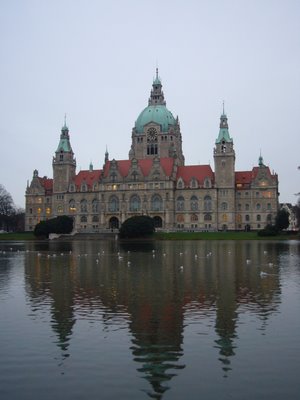
Next I walked around the old quarter and the main shopping streets of the city. Along the way I came across Hannover’s own small red light district, but without any street-walking prostitutes. I have read before that all decently sized German cities have their own sex-themed business and prostitution area.
Eventually I headed to the train station to wait for my bus out of the city. I killed time talking with a man from Egypt, who also happened to be a four-year first place winner of the national Danish body-building championship. One definitely meets some interesting folks while on the road.
At 11 o'clock I boarded my bus and fell asleep as we drove down the autobahn. I awoke to the sound of the driver's voice over the microphone, "Amsterdam."
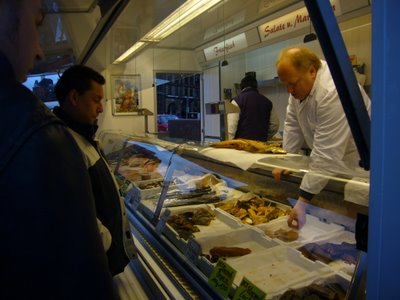

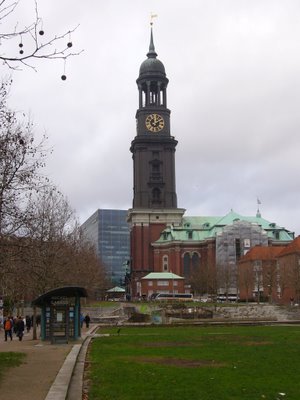


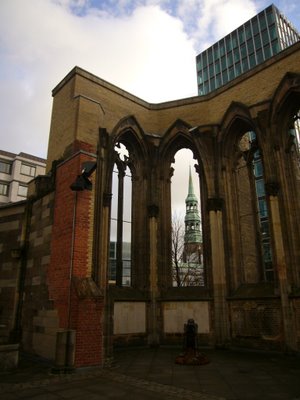

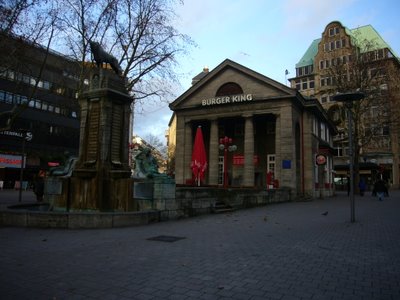
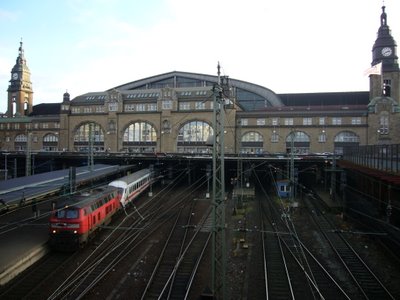












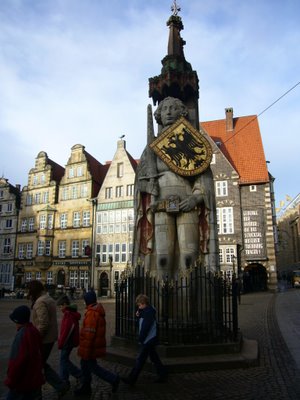

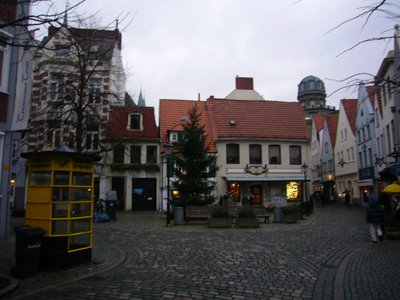
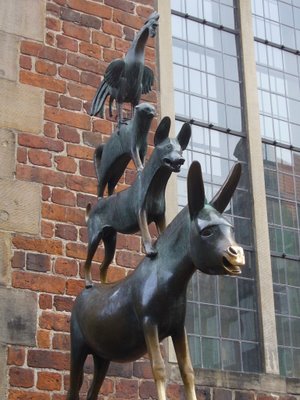
5 comments:
I heart Luebeck and Marzipan. When i was packing i found my frog of marzipan i had from there, he was so cute and little and green and all smashed up, sad :( on the other hand your encounters w/ prostitution made me laugh out loud, can't wait to read what you made of amsterdam :) -ing
Thanks. The prostitutes made me laugh too while they propositioned me, but afterwards when I really thought about it I was more a state of disgust. Still, a funny story. Amsterdam's coming soon.
Moin. Schönen Gruß aus Hamburg. your blog is really, really intresting to read. i went through most of your posts. very nice to read about your impressions from Regensburg (where I have relatives) and Hamburg (where I live). good you visited northern germany as well, for there are very strong regional differences in germany.
If you might ever get back to St. Pauli - you should, because there is such a vibrant nightlife beyond the whole sexindustrie - heres a proper hint from a resident to deal with the engaging ladies. simply state, that she propably won´t be able to satisfy you, the way you like it. She´ll be like: "Hey, which way do you like it". Your answer has to be: "I like it for free". Always works.
Do that one in German and you´re good. but you seem to be anyway. regards.
Oh, I forgot something (we Germans are all Besserwisser). you wrote: "As a port city, Hamburg has a few canals in the city center area. Not as many or scenic as those in Amsterdam or Venice mind you"
Actually Hamburg has more canals than venice and amsterdam together...
Alex: Danke schön. I'm glad you enjoy the posts. As for the canals in Hamburg, the majority of them must be in another area of town, because I really didn't see so many. I'll take your word on it though.
Post a Comment